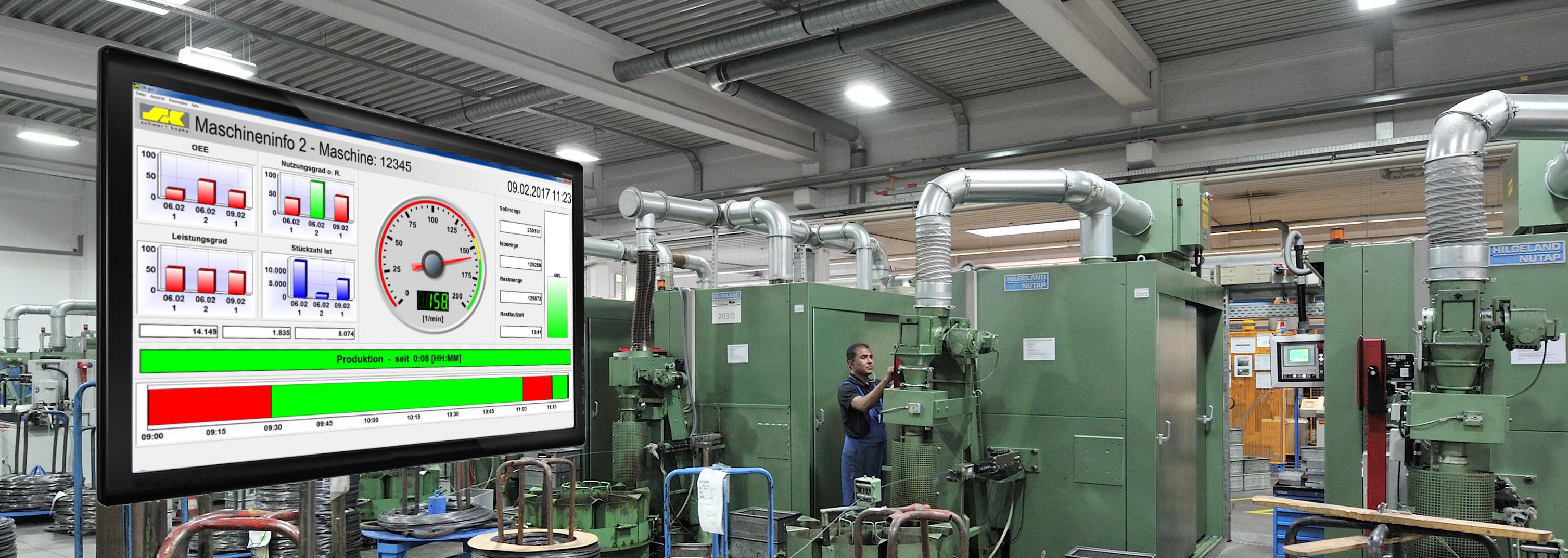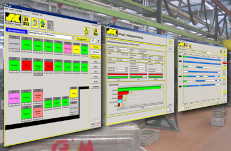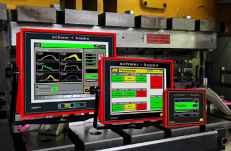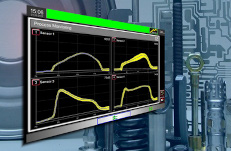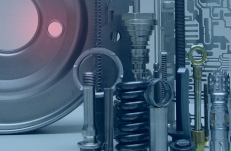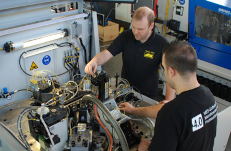MES-Definitionen
What exactly is OEE? What is the difference between machine and operating data? What are KPIs, key figures or scorecards?
The following definitions show our interpretation of the individual technical terms.
The plant data collection (PDC) connects the machine data with the operational resources.
The machine data is linked to the completed orders and articles. This always requires a machine terminal, via which the necessary messages such as job start, job end or job interruption can be made. Optionally, further data such as down codes, personnel attendance, batch changes, tool changes or rejects can be reported.
Usually the typical data feedback to the ERP system is performed automatically. A PDC system requires that the recording system is firmly networked with the IT environment of the manufacturing company. Interfaces to the ERP, CAQ, FEM or Personnel systems form the basis for this networking and ensure uniformity of the collected information. In addition, repair and maintenance tasks can also be recorded and evaluated.
CAQ systems are EDP-supported devices for quality assurance. Many users demand comprehensive documentation from their suppliers concerning the measures taken for ensuring quality during the manufacturing process. In series production, the so-called SPC inspections are usually required. Within the scope of these tests, the manufactured products are randomly measured or checked at regular, prescribed intervals. The measurement results in turn are documented in the form of control charts and are then compared to statistically calculated action limits. If the action limits are violated, corrective intervention in the production process is necessary.
Suitable interfaces between CAQ and MES ensure that the inspections are carried out at the actual due dates and that they are not forgotten. On the other hand, unnecessary inspections are avoided or not even required if, for example, the machine has either not produced at all or only temporarily during the current inspection period. Direct networking with the machine also allows an automatic stop of if due inspections are not carried out or if the measured values are outside the limits to be observed. Our MES software SK-go! has implemented suitable interfaces to all leading CAQ systems.
A batch is the raw material or product that originates from the manufacturing process and which can be used as a defined quantity for further processing.
In many productions, the use of individual batches and in particular batch changes must be precisely recorded and documented.
In order to ensure complete traceability of job-related production data, it is usually also necessary to record the material batches with which the order was manufactured. If more than one batch is used for a production order, each of them must be clearly identified. In this case, the MES records not only the order data but also the unique batch data. During this process, it is also frequently checked whether the batch that is used has also been released for the upcoming order.
Machine and production data can also be analysed batch-related afterwards. In the event of quality defects in the material, the batch assignment also allows tracing whether further production orders could possibly also be affected by this defect.
The ERP system generates manufacturing orders, does preliminary and post calculation, plans them for production and takes on business functions such as financial accounting, accounting and balance sheet management. ERP systems demand exact and prompt feedback on current order progress from production in order to optimally control business processes. The required bi-directional data exchange between the ERP system and the MES is usually guaranteed via configurable ERP interfaces.
MES receives comprehensive information from ERP about the planned orders such as the order number, the article to be produced, the required order quantity and the planned machine speed/output. In the response, MES continuously informs the ERP system about the current order progress and at job end about the actual up and downtimes, the quantities actually produced and any other data required.
Our MES software SK-go! has field-proven interfaces to all leading ERP systems.
Generally, the machine status is recorded automatically via the machine control or existing part mase pulses. Out of this, the exact up and downtimes, the quantities produced and the production speed can be clearly determined. A machine terminal is not necessary. Data acquisition runs automatically in the background and does not require any manual input by the machine personnel.
The collected data allows an evaluation of the degree of utilization of a machine, enables the analysis of the machine output (degree of performance) and precisely shows the stop/go runtime behavior.
The performance level of a machine reflects the ratio of the nominal output and the actual output expressed as a percentage. The formula for this is performance level [%]=actual output/nominal output. Usually, via the ERP interface, MES receives an order or article-related performance requirement, so that the performance level is calculated dynamically depending on the current order.
Alternatively, a fixed performance requirement for the machine can be used as a basis for calculation if, for example, the machine speed cannot be controlled.
In any case, with modern MES, the machine operator automatically receives a notification on his terminal if the current machine output does not correspond to the planned output.
According to the common definition, machine data collection (MDC) includes all information that describes the current performance of the machine. This includes the up and downtimes, the cycle rate or ratherspeed of the machine and the produced quantity. All of these are the basic input for the machine data. This information can be easily gathered from registering part made of pulses available from the machine control or from suitable sensors.
In a typical MDC, this information is supplemented at least by down codes, which classify the causes of machine downtimes into predefined categories. Normally, a machine terminal is required for entering down codes. An automatic input of digitally available fault messages from the machine control system is also common.
In general, the machine interface distinguishes between a physical interface with digital I/Os and a software interface.
The acquisition of the machine status via digital I/Os offers the advantage that signals for a clear description of the machine status are often already present in the machine controls, or can be retrofitted with little effort. Common MES terminals have several corresponding inputs and outputs and do not require any further software interface. In addition, numerous machines are already prepared for this type of connection with a suitable I/O module from the factory.
The OPC-UA interface has established itself as an international standard, enabling a secure and clearly defined exchange of data between the technical systems of different manufacturers. The OPC-UA interface is regarded as a prerequisite for future-proof data communication in the sense of Industry 4.0 and for the Internet of Things (IoT). It was developed by the OPC Foundation, whereby the UA stands for Unified Architecture.
Our current MES terminals and process monitoring systems have an OPC-UA interface.
The degree of utilization of a machine reflects the ratio of the target production time according to the specification from the shift calendar and the actual production time recorded in real terms as a percentage. Therefore, the formula for this is
degree of utilization [%]=actual production time/target production time.
Therefore, a poor degree of utilization inevitably results from frequent machine downtimes, e.g. due to technical or organisational faults.
OEE indicators are also internationally used as a standard of comparison. The overall equipment effectiveness (OEE) is calculated by multiplying the following percentages:
Availability: how long has the plant been in production and how long has it been inoperative? This figure usually corresponds to the classical degree of utilization and reflects the losses due to downtimes.
Performance efficiency: has the plant operated with the required output per unit of time? Performance efficiency or performance level describes the losses caused by insufficient machine output or speed (parts per unit of time).
Quality rate: how large is the proportion of flawless products (quantity produced minus the reject rate during the period under consideration)? It reflects the losses incurred by rejects.
Thus, the OEE factor is the main key figure as such. It contains all elements describing productivity or non-productivity of production plants.
The quality rate is defined as the ratio between the yield produced and the total production quantity. For the calculation of the quality rate, the scrap quantity incurred must be recorded. This can be done, e.g., by manual input which is made directly at the machine terminal, or by comparing the total production volume recorded with possibly existing weighing of the actual yield.
The benefit in time (degree of utilization) of a machine is determined on the basis of the recorded production time in relation to the scheduled production time. The scheduled production time is reflected in the currently valid shift calendar. The theoretically possible output of a machine per shift, day, week, month and year is also calculated from the scheduled overall production time, an expected average use, and the job-related planned performance.
The shift calendar can be stored for each machine, machine group, department, plant and client. In order to determine the actually available production time in the most practice-oriented way possible, a prompt and regular maintenance of the shift calendar in the MES software is immensely important.
The correct recording of reasons for malfunction is the prerequisite for a Pareto error analysis and the evaluation of sources of malfunction and events. With predefined lists for each machine, the down reasons of a system can be justified, standardised and archived. In the event of machine downtime, modern MES solutions inevitably require down codes to be entered in order to receive the most complete data possible.
Via a suitable interface (e.g. in the form of binary codes), fault messages can be taken over directly from the machine control where appropriate. In this case, no additional entry by the machine operator is required.





